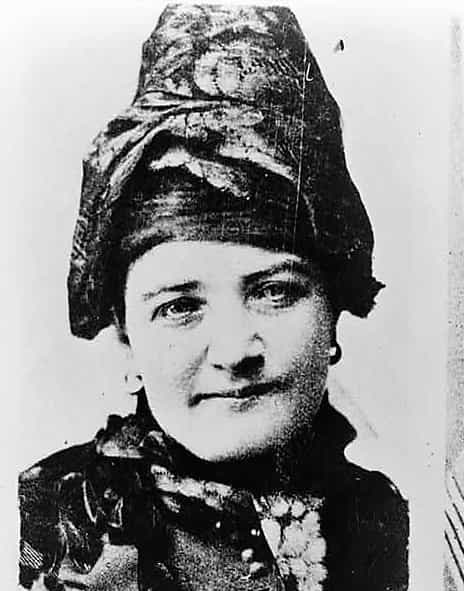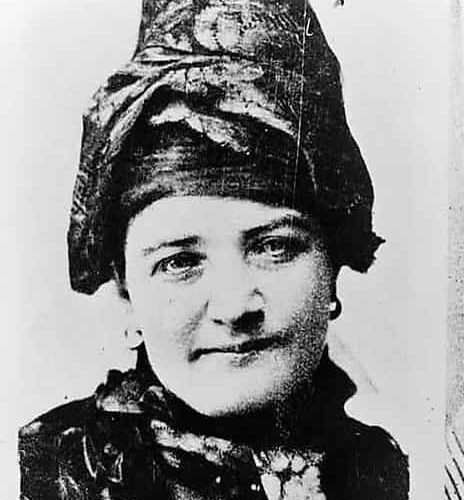The Incredible True Story of Sophie Lyons: From Crime Queen to Compassionate Reformer

Meet Sophie Lyons, a name that once struck fear into the hearts of police officers and admiration in the shadowy world of 19th-century criminals. Known as the “Queen of Crime,” Sophie’s life was a rollercoaster of daring heists, prison escapes, and an astonishing transformation into a respected writer and advocate for the poor.
This is her story, told in simple English, perfect for anyone curious about history’s most fascinating characters.
Early Life: Born into Crime
Sophie Levy (later Lyons) was born on December 24, 1848, in New York City. Her parents were not ordinary folks. Her mother, Sophie Elkins, was a skilled shoplifter, and her father, Sam Levy, spent most of his time in jail for burglary. Growing up, Sophie never went to school. Instead, her parents taught her how to steal. By the time she was a child, she could pick pockets and swipe goods from stores with ease.
One day, young Sophie refused to steal after talking to girls her age who lived honest lives. Her father responded by threatening her with a hot poker, forcing her back into crime. This harsh lesson stuck with Sophie. By her teenage years, she was a master thief, living in a world where crime was the only way to survive.
Marriage, Pickpockets, and Prison
At 16, Sophie married Maury Harris, a smooth-talking pickpocket. But when Harris was arrested, Sophie left him, unimpressed by his lack of skill. Soon after, she met Ned Lyons, a famous bank robber admired in criminal circles. Ned promised Sophie a life of luxury, free from stealing. They married, and Sophie enjoyed a brief period of wealth, with servants and a fancy home on Long Island.
But old habits die hard. While Ned was out robbing banks, Sophie couldn’t resist sneaking into Manhattan to pick pockets. After having her first child, George, in 1870, she tried to quit crime—for six months. When she was caught stealing at a New Hampshire fair, she cried and acted so innocent that the police let her go.
Sing Sing Prison and a Daring Escape
Sophie’s luck ran out in 1871. She was arrested for grand larceny (stealing expensive items) and sentenced to five years at Sing Sing, a tough New York prison. Ned was also sent to Sing Sing around the same time. But Sophie had a plan. She pretended to be a model prisoner, working as a servant for the head matron. This gave her freedom to walk outside the prison with the matron’s children.
During one of these walks, she met a member of Ned’s gang. Together, they plotted Ned’s escape. Days later, Ned simply walked out of prison. He then helped Sophie escape using a wax copy of a prison key. The couple fled to Canada, living off stolen money. But Sophie grew tired of crime and begged Ned to leave that life behind. When he refused, they split up—only to reunite later for more heists.
The Queen of Crime Rises
By the 1880s, Sophie Lyons was legendary. Newspapers called her the “Queen of Crime,” a title given by the New York police chief. She teamed up with Billy Burke, a thief who later became her third husband. Unlike many criminals, Sophie hated violence. She used clever tricks instead. For example, she once posed as a wealthy socialite to steal jewels from European elites.
In Paris, Sophie pretended to be “Mary Wilson,” a gold miner’s daughter, and even fooled the Vanderbilt family. When caught pickpocketing there, her rich friends and the American ambassador vouched for her, claiming it was a mistake. She later stole $250,000 worth of jewels in Paris, only to spend it all on luxury.
A Mother’s Heartbreak
Sophie’s personal life was messy. She had four children with Ned Lyons but struggled to balance motherhood and crime. Her daughter Esther was so ashamed of Sophie’s reputation that she begged her never to visit her in Canada, where Esther lived in a convent. Sophie’s other children also faced challenges, but she tried to provide for them through both legal and illegal means.
From Criminal to Crusader: Sophie’s Reform
By the 1890s, Sophie was in her 40s and tired of running from the law. After a partner swindled her, she decided to change her life. “I want something more than property. I want the respect of good people,” she said.
She started by investing in real estate, making honest money for the first time. In 1897, the New York World hired her as America’s first society columnist. Using her charm and connections, she wrote gossip about the rich and famous, becoming a celebrity herself.
But Sophie’s biggest change was her work helping others. She wrote pamphlets urging criminals to reform, donated pianos and books to prisons, and even opened a home in Detroit for children whose parents were in jail.
A Tragic End
Sophie’s final years were peaceful until May 8, 1924. Three men she’d tried to help attacked her in her Detroit home, believing she hid treasure there. They beat her badly, and she died that night at 76. Her estate was worth 1million(about1million(about15 million today), but she left only $100 to her estranged daughter Esther—a reminder of their broken relationship.
Why Sophie Lyons Matters Today
Sophie Lyons’ story is more than a tale of crime. It’s about redemption, second chances, and the power of change. She showed that even someone labeled a “queen” of evil could transform into a force for good.
Frequently Asked Questions (FAQ)
1. Who was Sophie Lyons?
Sophie Lyons (1848–1924) was a famous American criminal known as the “Queen of Crime” in the late 1800s. She started her life as a thief and con artist but later became a society columnist, author, and advocate for prison reform. Her dramatic life story includes daring heists, prison escapes, and a surprising turn toward helping others.
2. Why was Sophie Lyons called the “Queen of Crime”?
The New York City chief of police gave her this title in the 1880s because of her unmatched skills in pickpocketing, bank robberies, and blackmail. She stole from wealthy elites across Europe and America, earning respect (and fear) in the criminal underworld.
3. How did Sophie Lyons escape prison?
In 1872, while serving time at New York’s Sing Sing prison, Sophie tricked guards by acting like a model prisoner. She became a servant to the head matron, which let her walk outside with the matron’s children. During these outings, she met a gang member who helped her husband, Ned Lyons, escape. Later, Sophie copied a prison key using wax and fled to Canada.
4. Was Sophie Lyons ever violent?
No! Unlike many criminals of her time, Sophie hated violence. She relied on clever tricks, disguises, and persuasion to pull off crimes. For example, she posed as a wealthy socialite to steal jewels or used tears to talk her way out of arrests.
5. Did Sophie Lyons have children?
Yes, she had four children with her second husband, Ned Lyons. However, her criminal lifestyle strained her relationships. Her daughter Esther was so ashamed of Sophie’s reputation that she cut ties and asked Sophie never to visit her in Canada.
6. How did Sophie Lyons go from criminal to reformer?
By the 1890s, Sophie grew tired of crime. After a partner cheated her, she decided to live honestly. She invested in real estate, wrote for the New York World as a society columnist, and published guides urging criminals to reform. She also built a home for children with jailed parents and donated money to improve prisons.
7. What happened to Sophie Lyons in the end?
At age 76, Sophie was attacked in her Detroit home by three men she’d tried to reform. They beat her, believing she hid treasure there, and she died from her injuries on May 8, 1924. Her estate was worth 1million,butsheleftonly1million,butsheleftonly100 to her estranged daughter Esther.
8. Why is Sophie Lyons important today?
Her story shows that people can change, no matter their past. Sophie used her fame to help others, proving that redemption is possible. She also highlighted the struggles of prisoners’ families, a topic still relevant today.
9. Did Sophie Lyons write anything?
Yes! After reforming, she wrote society gossip for the New York World and published pamphlets like Why Crime Does Not Pay to discourage others from following her old path.

